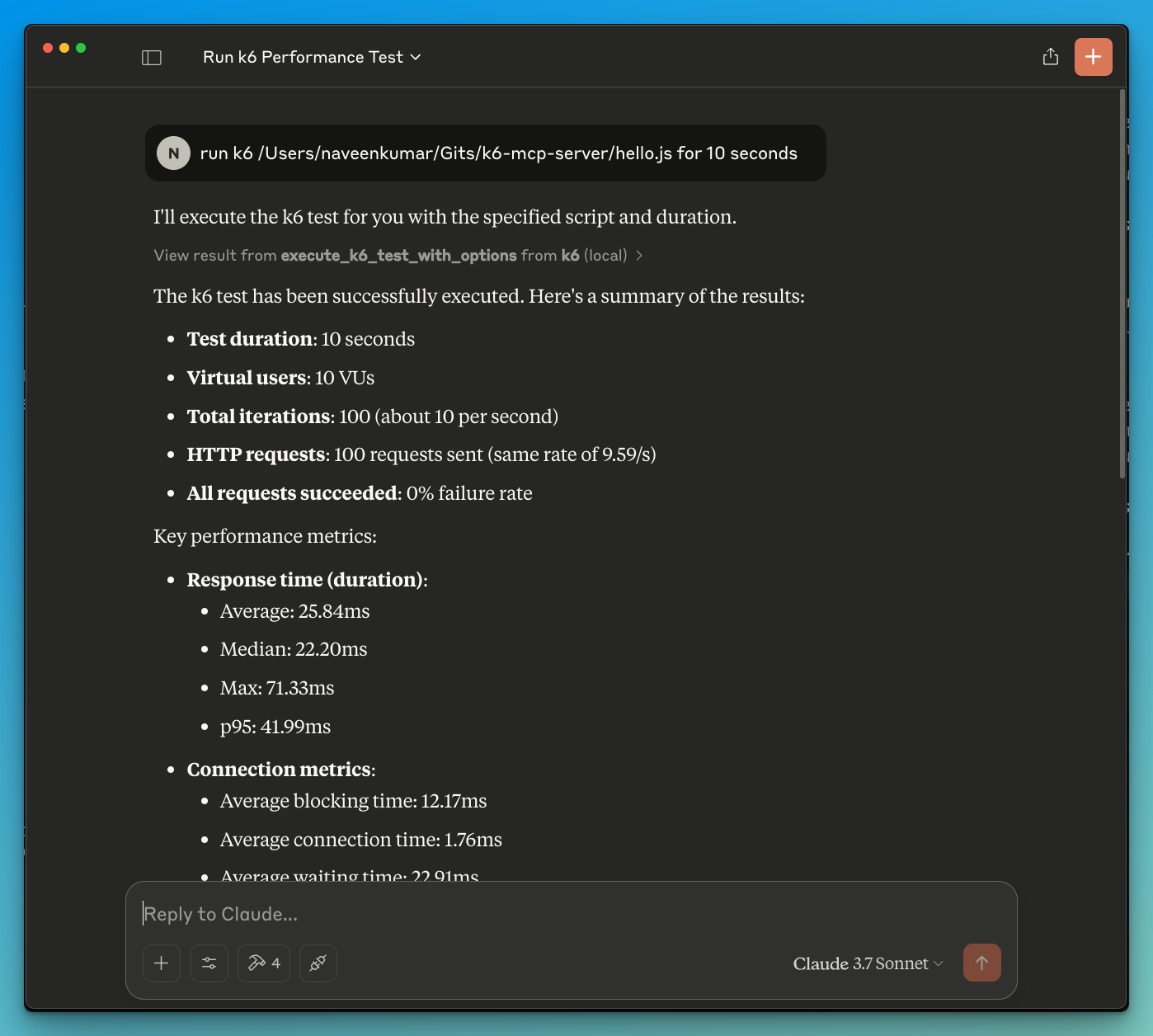🚀 ⚡️ K6 Mcp 服务器
k6 MCP 服务器
概览
什么是 k6 MCP 服务器?
k6 MCP 服务器是一个强大的工具,旨在对应用程序进行性能测试和负载测试。它利用了 k6 测试框架的能力,该框架以其高效性和易用性而闻名。MCP(微服务控制平面)服务器允许用户管理和编排多个 k6 测试脚本,使其能够无缝集成到 CI/CD 管道中,并提供一个集中平台来监控和分析性能指标。
k6 MCP 服务器的特点
- 集中管理:k6 MCP 服务器提供一个单一界面来管理多个性能测试,使得在不同环境中组织和执行测试变得更加容易。
- 实时监控:用户可以实时监控测试结果,立即洞察应用程序性能并快速识别瓶颈。
- 与 CI/CD 集成:该服务器可以轻松集成到现有的 CI/CD 工作流中,促进作为开发过程一部分的自动化性能测试。
- 可扩展性:k6 MCP 服务器设计用于处理大量并发用户,可以模拟复杂的用户场景,以测试应用程序在负载下的性能。
- 详细报告:该服务器生成全面的报告,提供各种性能指标的洞察,帮助团队根据数据做出明智的决策。
如何使用 k6 MCP 服务器
- 安装:首先在您选择的环境中安装 k6 MCP 服务器。请按照官方文档中的详细安装说明进行操作。
- 配置:配置服务器设置以匹配您的测试要求。这包括设置测试脚本、用户场景和性能阈值。
- 运行测试:使用服务器界面启动性能测试。您可以选择特定的测试脚本并定义要模拟的虚拟用户数量。
- 监控:在测试运行期间,通过服务器仪表板实时监控性能指标。
- 分析结果:测试完成后,查看生成的报告以分析性能数据并识别需要解决的任何问题。
常见问题解答
k6 MCP 服务器的主要目的是什么?
k6 MCP 服务器的主要目的是促进应用程序的性能测试和负载测试,提供一个集中平台来管理多个测试脚本和监控结果。
我可以将 k6 MCP 服务器与现有的 CI/CD 管道集成吗?
是的,k6 MCP 服务器旨在与 CI/CD 管道无缝集成,允许作为开发工作流一部分的自动化性能测试。
k6 MCP 服务器如何处理大规模测试?
k6 MCP 服务器构建为可扩展,允许用户模拟大量并发用户和复杂的用户场景,使其非常适合在高负载下测试应用程序。
k6 MCP 服务器生成什么样的报告?
k6 MCP 服务器生成详细的性能报告,包括响应时间、吞吐量、错误率和资源利用率等指标,帮助团队全面了解应用程序性能。
使用 k6 MCP 服务器需要许可证吗?
是的,k6 MCP 服务器在 MIT 许可证下提供,允许免费使用、修改和分发。
详情
🚀 ⚡️ k6-mcp-server
A Model Context Protocol (MCP) server implementation for running k6 load tests.
✨ Features
- Simple integration with Model Context Protocol framework
- Support for custom test durations and virtual users (VUs)
- Easy-to-use API for running k6 load tests
- Configurable through environment variables
- Real-time test execution output
🔧 Prerequisites
Before you begin, ensure you have the following installed:
- Python 3.12 or higher
- k6 load testing tool (Installation guide)
- uv package manager (Installation guide)
📦 Installation
- Clone the repository:
git clone https://github.com/qainsights/k6-mcp-server.git
- Install the required dependencies:
uv pip install -r requirements.txt
- Set up environment variables (optional):
Create a
.envfile in the project root:
K6_BIN=/path/to/k6 # Optional: defaults to 'k6' in system PATH
🚀 Getting Started
- Create a k6 test script (e.g.,
test.js):
import http from "k6/http";
import { sleep } from "k6";
export default function () {
http.get("http://test.k6.io");
sleep(1);
}
- Configure the MCP server using the below specs in your favorite MCP client (Claude Desktop, Cursor, Windsurf and more):
{
"mcpServers": {
"k6": {
"command": "/path/to/bin/uv",
"args": [
"--directory",
"/path/to/k6-mcp-server",
"run",
"k6_server.py"
]
}
}
}
- Now ask the LLM to run the test e.g.
run k6 test for hello.js. The k6 mcp server will leverage either one of the below tools to start the test.
execute_k6_test: Run a test with default options (30s duration, 10 VUs)execute_k6_test_with_options: Run a test with custom duration and VUs

📝 API Reference
Execute K6 Test
execute_k6_test(
script_file: str,
duration: str = "30s", # Optional
vus: int = 10 # Optional
)
Execute K6 Test with Custom Options
execute_k6_test_with_options(
script_file: str,
duration: str,
vus: int
)
✨ Use cases
- LLM powered results analysis
- Effective debugging of load tests
🤝 Contributing
Contributions are welcome! Please feel free to submit a Pull Request.
📄 License
This project is licensed under the MIT License - see the LICENSE file for details.
Server配置
{
"mcpServers": {
"k-6-mcp-server": {
"command": "docker",
"args": [
"run",
"-i",
"--rm",
"ghcr.io/metorial/mcp-container--qainsights--k6-mcp-server--k-6-mcp-server",
"python main.py"
],
"env": {}
}
}
}